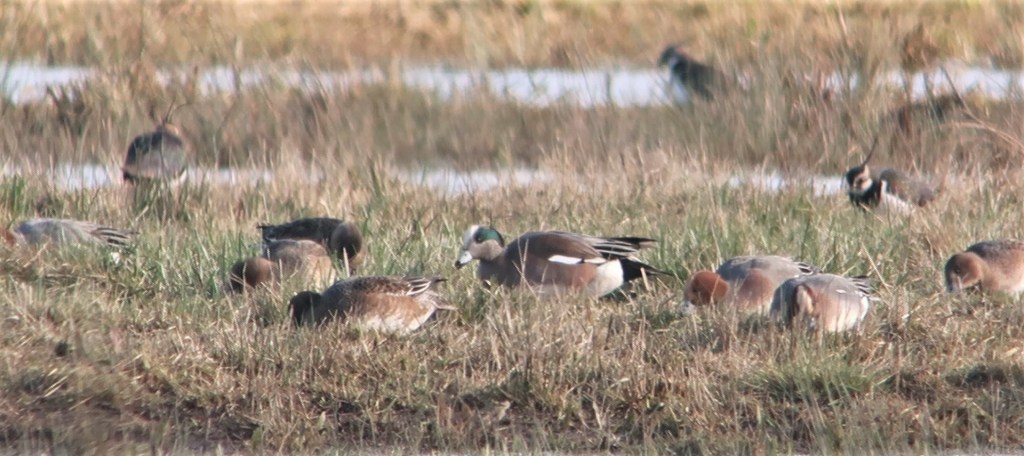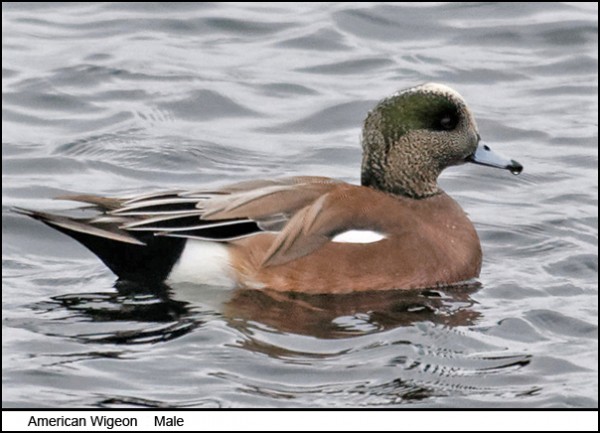A number of American Wigeon have been reported around England in recent weeks, and being an attractive Nearctic equivalent of one of our own most abundant winter wildfowl I had been tempted to travel a modest distance, say Somerset but not Yorkshire to connect with one. It is a duck I had experienced just once before, also within my home county in February 2011. Now, a little after 9am today the local grapevine announced the presence of a drake on my doorstep, and hence I welcomed the opportunity to move swiftly on both in blogging terms and actually on the ground from a rather dismal last post herein.
I was about to set out on my weekly food shop as the alert came in, and stuck to that plan reasoning the more company there might be when I arrived on site the better would be my chances of success. In the supermarket I ran into an Otmoor birder who told me the patch regulars had searched for this scarcity over the weekend, it’s presence being suspected. Since presumably the same individual was spotted at dusk in north Oxford’s Port Meadow on 12th January, the expectation has been it might remain somewhere locally. Now it had been relocated by the RSPB warden on the “flood field” to the north of the reserve’s visitor trail area (see here).

That location is viewable from a bridle path (SP564146) between the villages of Oddington and Horton-cum-Studley. Given the interval since the last twitchable county record, AW is a bird that more recent published county listers than myself need. One of those, who is getting close to myself in the “league table”, was cycling away and back to work as I walked to the flood field. He said there were very many Eurasian Wigeon to pick our quest out from distantly, looking into glary light with a significant shimmer. That was the sort of difficulty level I was expecting and onward I trod.
I passed more people who had given up or had no more time on my way out, so when I arrived at the viewing point itself there was just myself and one other Oxon birder left to scan the distant Wigeon flock. We were soon joined by a well-known national birder who called the American Wigeon at just after 12:30pm. By then several social media driven people who like to take pictures of birds had also turned up, but they soon lost interest again when they found this one was too far away for that. Next I was joined by Badger with whom I continued to watch the bird for the next couple of hours.
The AW remained on view intermittently throughout that time and after I left, things being a matter of picking it out of the constantly shifting flock. It took me a while to get onto it, as can be my wont, but when I did so this duck was unmistakable. It is a medium-sized, rather compact species with a rounded head and short, blue-grey, black-tipped bill. Breeding males have a brownish grey head with an iridescent green band behind the eye and a very distinctive creamy-toned cap. The breast and flanks are pinkish brown with two white patches on the sides of the rump that together with the black under-tail feathers are all very noticeable at distance.
I have selected the outsourced image (above) as it most resembles the plumage today’s bird was in, presumably coming into its full breeding finery. This is a common and widespread duck throughout north America and a regular vagrant to the British Isles and Europe. The main breeding grounds lie in the north-west of the continent (Canada and Alaska) and they winter from the US north-west to Mexico, other central American countries and the Caribbean.
Otmoor in February invariably offers a wildlife spectacle. Its flooded fields hold quantities of Wigeon, Teal and other dabbling ducks, out of which at intervals rise swirling flocks of Golden Plover and Lapwing. Witnessing all this is always uplifting and as much so again today as ever in my currently unmotivated state. And the American Wigeon provided something extra. What was there not to like?

